Choosing the right waders and boots - plus the right size - is often a big challenge for many anglers who want to invest in this indispensable piece of fishing equipment. In such a situation, a large number of questions arise, to which not everyone can always find the right answers. If you are one of this group of undecided fishermen, don't worry! In this guide, we will certainly find a solution to your dilemmas regarding choosing the best waders and wading boots exactly for you!
FISHING WADERS: Under all these terms today we imagine breathable waders, which can probably be said to be the last development stage of high fishing water-resistant pants, thanks to which - we fishermen - we get in water and into deeper places in complete dryness and sufficient comfort!
With a little look back in history - thin breathable waders were preceded, for example, by all-rubber versions of high fishing waders made of heavy and non-adaptable rubber, which gradually became the relatively popular lighter and more adaptable PVC waders. Both of these types of fishing waders were firmly connected with rubber boots, which were not a completely safe type of boots on all surfaces and in various river terrains!
Probably the most used type of high fishing waders could certainly was neoprene waders, which could be purchased, for example, in combination with neoprene socks, on which it was possible to wear solid leather wading boots with rubber or felt soles. Neoprene waders were especially practical in the cold autumn, winter and early spring, as they are very warm and many anglers still use them for these purposes today. However, what is an advantage in winter, is suffering in summer, and all those who owned or own neoprene waders will certainly confirm this statement to me!
A common feature of these above-mentioned types of fishing waders is their complete airtightness and thus zero removal of body moisture out of the pants, which results in wet underwear in any weather and outside temperatures.
The optimal solution for light and adaptable waders, which would even "breathe" - they wick away body moisture through their one-sided breathable membrane and, in addition, which could be worn with solid wading boots, came with the breathable tights we know today in a huge quantity, quality, price range and in the offer of various manufacturers!
And in view of all the above, in this article I will describe just the most important aspects that we need to know to make the right choice!
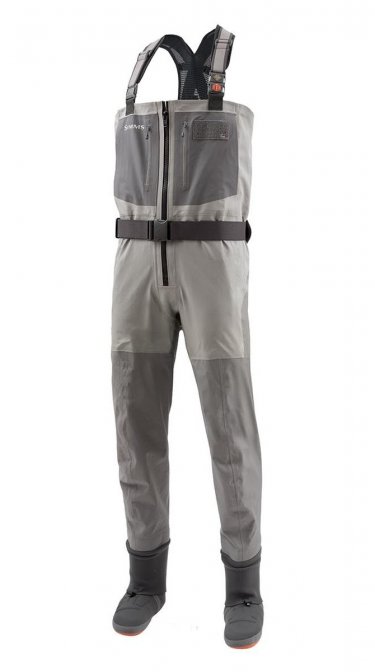
The size of waders is probably the most important parameter that you should solve when choosing them - right after their price! Always follow the official size charts of the manufacturer, thanks to which you - in conjunction with your body proportions - should choose the most suitable size of waders just for you! Don't worry - since the original size range "S - XXL" has been expanded by other special intermediate sizes (MK, LL, XLS, etc.) - you will definitely choose tailor-made waders!
Always choose the size with a certain reserve, eg for situations where you wear more insulating layers (cold months). You won't go to town or business meetings in waders, so you don't have to worry about whether they fit your body perfectly. If so, you have chosen the wrong size! You have to realize that in your waders you will actively move, bend, turn, walk on water, march through various terrain, sometimes you will have to kneel while fishing, or slide down a steep slope, etc.
When choosing the wrong/small size of waders, there is a risk of excessive stress and stretching of the material, either in the seams or the fabric itself, which results in damage to the material and gradual leakage of external water into the pants!!!
At one time, there were also opinions that waders must be purchased in the largest possible size in order to avoid the above-mentioned damage to the material. This is, in my opinion, another extreme action, because waders that are too large - excessive - risk other possibilities of material damage (eg catching on a branch and tearing) or uneven wear of the material in a large number of its bends and folds.
Good TIP: If you like to fish on a Belly-Boats, you should get one more waders at least a lot bigger for this style of fishing! Definitely do not use waders in which you normally catch on the river and which will fit you perfectly according to the above aspects. Due to the kicking of the fins, the material of the waders is gradually pulled up towards the crotch and the fabric is thus switched off on the knees. In this case, the material and seams expand, which leads to a gradual leakage of external water into the pants - the waders begin to leak water and once they start, they usually do not stop! ;-)
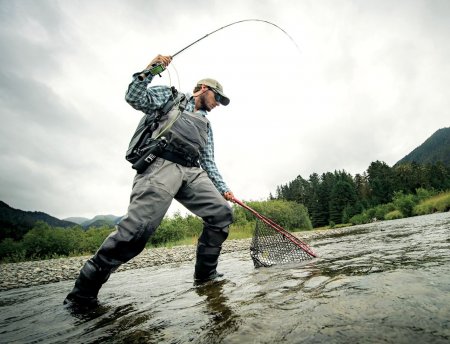
The material of waders is directly related to their price. Today, many materials are used in the production of breathable waders in various numbers of layers, the most used of which are specially modified polyester or nylon-taslon fibers, Toray, etc. - cheaper variants. For a long time, however, the miraculous water-impermeable and highly breathable GORE-TEX material has been on top, which you can find in various numbers of layers, but especially in the most expensive types of waders.
In this case, you have to ask yourself the following questions, for example: How often do I actually go to the water? What types of waters do I visit? How hard terrain do I usually move in? Do I just want to make myself happy? What version of the truth will I use when my wife asks for a prize? :-)
Once you honestly answer these questions, you will simplify the whole situation with choosing expensive waders! Even so, I will try to help you with the following system of simple selection equations!
- You go to the water really often (several times a week) + you go fishing and visit abroad + you visit various types of water + you need to rely on your equipment + you are not bothered so much by the financial situation = Clearly get quality Gore-Tex waders of the highest quality, the investment definitely worth it!
Simms G3 Guide Stockingfoot Gunmetal
- You can go fishing a few times a month + the area you are visiting is well known (you know what you can expect) + you usually fish not far from the car, there is no unexpected situation + you are not one of the types of people who would "throw away" the monthly payment for consumables clothing = Get reliable waders in the best price/performance ratio and you will be satisfied!
Simms Freestone Z Stockingfoot Smoke
Simms Freestone Stockingfoot Midnight
- Due to work and other duties, you only get to fish occasionally / the most important role is played by your financial situation (students) / you don't know how often you will devote yourself to your new hobby (beginners), or combination of all together = The best choice for you will be cheap waders that will fulfill their purpose and in the event that anything from the above changes over time, for example, nothing prevents you from choosing a better version of waders!
=> Suitable types:
Simms Tributary Stockingfoot Basalt
Simms Tributary Stockingfoot Tan
- Special situation: You travel a lot and very often and you solve every gram on the plane + but you still want quality and as compact waders that you can rely on in all conditions = Simms Guide Classic Stockingfoot Carbon
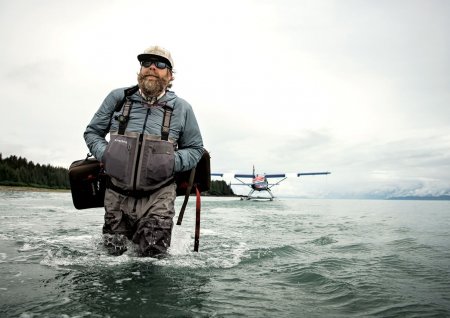
Zipper, or Not?! This point generally refers to any "practical accessories" that can potentially impair the quality, water resistance and breathability of waders. Generally speaking, the rule applies to conventional waders: Any component that makes the cut and concept of the waders more complicated can cause problems!
From the logic of the matter, I must state that this is clearly true and the above rule applied mainly to earlier "initial" models. Previously, the production technology was not yet at such a level that it could afford to complicate the cutting of breasts without any problems in the future!
Nowadays, this is no longer so true and - although of course, as with any consumer item, we may encounter some problems - I can say that especially with the more expensive models, the manufacturers have all the details really practically thought out and very well made!
E.g. the waterproof zipper already mentioned in the title! Be sure to consider whether you will use it on your waders and if so, go ahead! It is a very practical accessory, which you will appreciate especially during summer wading, when you can have your waders open most of the time, or vice versa when fishing in bad and cold and rainy weather, when you need go a pee.
So if you are hesitant whether to buy a specific type of waders in the classic or "zipper version", I will of course leave the final decision to you, but nowadays you do not have to be afraid to try i zippered version! ;-)
Other accessories: There are very practical different types of pockets on the breasts, whether waterproof, which you can use for storing boxes with flies and other accessories, but also the large chest pocket insulated with micro-fleece, in which you can warm your fragile hands! This is, for example, a very important part of good waders for me.
Almost all Simms waders have an excellent detachable inner pocket for leader material (photo in the gallery), a retractor and a foam Fly Patch for used flies. You can have this pocket hidden behind the edge of your waders, but as soon as you need it, you can flip it to the outside of your pants - it's a very nice and practical accessory!
You can find protective gravel guards on waderss either in the form of neoprene or of the same material as the material of the waders. Fortunately, this accessory is now a matter of course (previously, for example, neoprene gravel guards had to be purchased). In my experience, the neoprene ones are more durable, because the other made of breathable material are not so strong and, for example, they break easily when in contact with a sharp stone.
The obvious accessories for waders include high-quality soft and adjustable suspenders with fastening to carabiners, D-rings for attaching pliers, scissors, etc., adjustable belt, inner pockets, etc.
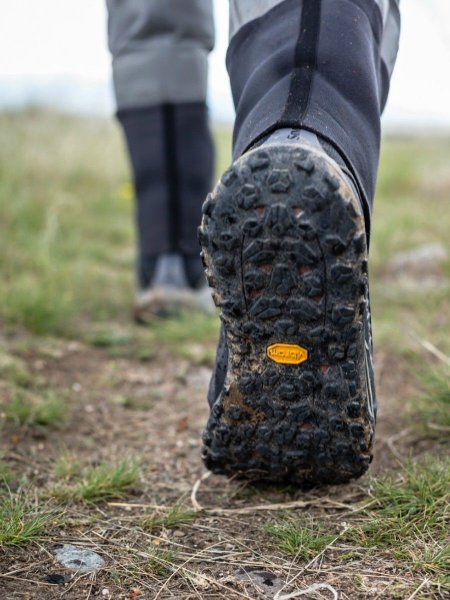
WADING BOOTS are nowadays an integral part of waders. Of course, there are also versions of the wand firmly connected with rubber boots, but their meaning (the advantage is perhaps only in the lower price compared to stockingfoot waders with boots) I have not fully understood yet.
Wading boots are nowadays made mainly of artificial leather, solid synthetic textile and rubber, and depending on the processing and material used, their final price is also formed! It doesn't make sense to disassemble the wading boots in as much detail as I did with the waders, but I will mention here mainly my personal observations, which are good to take into account when choosing quality wading boots!
Size of wading boots: At this point, proceed in the same way as for waders, so start from the manufacturer's size chart and count on a certain reserve for a neoprene sock, which you can fill more with a warm woolen sock in the cold months. Personally, I've always bought a bigger number of shoes from different manufacturers! In translation - I have shoes for everyday wear 11/44, so I buy wading shoes 12/45!
Rubber, or felt? We talk about soles, of course! Boots with a rubber sole are more expensive, but last longer and glide less on a wet surface, compared to cheaper felt soles, which wears out relatively quickly and slides on wet grass and slippery stones, for example. However, it can be better restored by gluing a new felt sole. Today, it is also possible to screw steel studs into both types of soles, which increase the anti-slip effect! I'll leave the decision to you, both solutions are very good, anyway, I personally support Vibram!
For more sophisticated models of wading boots, which are "assembled" from several material layers, always make sure that these individual materials are not only glued together, but also stitched! Even with expensive wading boots, it has already happened to me that the individual materials have come together and the shoes have literally disintegrated! Paradoxically, the simplest textile wading shoes lasted the longest - I still have the laces of them (about 15 years) and I use them repeatedly in new boots, where the original laces break. :-)
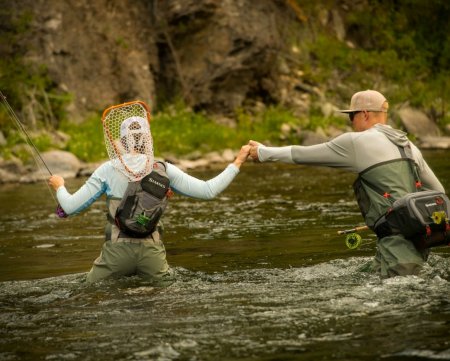
MAINTENANCE OF WADERS & WADING BOOTS is an important part of wearing them! But don't worry, it's not something that requires expertise! It is important that you do not leave your waders and boots in moisture after using them, and ideally hang your waders and leave boots in a shady and well-ventilated area where the wet material dries well and the water in it has no chance to rot!
Never dry wet waders and wading boots in direct sunlight - the water evaporates too fast and the material does not adapt immediately! Wading boots then shrink very quickly, rubber and leather parts can peel off and crack!
Be sure not to leave waders and boots wet in the car! If you get a lot of dirt, eg with clay, etc., clean the surface dirt with a soft brush, for example, and then you can spray it with clean water and let it dry.
Be sure not to wash waders or boots in the washing machine! If you want to impregnate the waders additionally, soak them completely in water and treat them with several even layers of impregnation spray (Revivex) when wet.
In case of puncture of the breathable material, seal the hole or crack with Aquasur in a dry state or have it repaired by an authorized service center.
Final TIP: Despite all the mentoined above - during summer fishing, leave your waders at home whenever possible, and wander the river, for example, only in shorts and sandals or Crocs! It is a much freer way of fishing and moving in the water, while at the same time you are pleasantly hardened by the cold water and the overall feeling from the very stay in nature is much happier! ;-) Tight Lines, Aleš



































